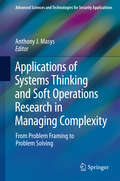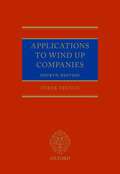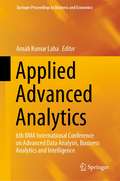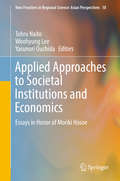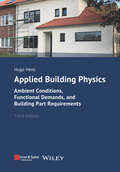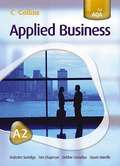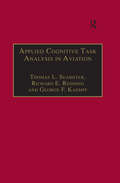- Table View
- List View
Applications of Systems Thinking and Soft Operations Research in Managing Complexity: From Problem Framing to Problem Solving (Advanced Sciences and Technologies for Security Applications)
by Anthony J. MasysThis book captures current trends and developments in the field of systems thinking and soft operations research which can be applied to solve today's problems of dynamic complexity and interdependency. Such ‘wicked problems’ and messes are seemingly intractable problems characterized as value-laden, ambiguous, and unstable, that resist being tamed by classical problem solving. Actions and interventions associated with this complex problem space can have highly unpredictable and unintended consequences. Examples of such complex problems include health care reform, global climate change, transnational serious and organized crime, terrorism, homeland security, human security, disaster management, and humanitarian aid. Moving towards the development of solutions to these complex problem spaces depends on the lens we use to examine them and how we frame the problem. It will be shown that systems thinking and soft operations research has had great success in contributing to the management of complexity.
Applications of the Input-Output Framework (Springer Proceedings in Business and Economics)
by Kakali MukhopadhyayThis book provides a fresh perspective on the ever-growing relevance of input-output analysis in problem solving. It is based on the “19th National Conference of the Input-Output Research Association of India (IORA)”, held in 2017 in Mumbai, India. The conference promoted the exchange of ideas on input-output analysis and related methods among economists, government officials, policymakers, academicians and industrialists. The book captures the unique ideas of prominent scholars, extends the basic “input-output framework,” analytical tool, outlines the possible impacts of some major policy decisions adopted by the Government of India, and puts forward concrete policy suggestions. In addition, it highlights the versatility of the Leontief model, which is currently being extended to cover a diverse spectrum of policy issues, ranging from agricultural productivity to science and technology and from carbon hotspots to energy and environmental consequences. A perfect blend of theory and application, the book provides a realistic outlook on sensitive economies and interdependencies between sectors.
Applications to Wind up Companies
by Derek FrenchThis book deals with the procedure for obtaining a winding-up order chronologically from presentation of a petition through to making the order. It also looks at the application process as it applies to various classes of petitioner, such as creditors, contributories (shareholders) and public officials. The fourth edition is completely updated to cover new legislation and new procedures. It includes new coverage of the Insolvency (England and Wales) Rules 2016, which rewrote the procedural rules for applications to wind up companies. The book also covers Regulation (EU) 2015/848 on insolvency proceedings (recast) concerning amended rules applying to jurisdiction, as well as new provisions for housing and education administration. Though focused on the procedure in the courts of England and Wales, the work also considers the jurisprudence of the many Commonwealth jurisdictions which have adopted the English procedure. This work contains all there is to know about applying (petitioning) to have companies and similar entities wound up by the court, making it essential for all lawyers who make, or defend, such applications.
Applications to Wind up Companies
by Derek FrenchThis book deals with the procedure for obtaining a winding-up order chronologically from presentation of a petition through to making the order. It also looks at the application process as it applies to various classes of petitioner, such as creditors, contributories (shareholders) and public officials. The fourth edition is completely updated to cover new legislation and new procedures. It includes new coverage of the Insolvency (England and Wales) Rules 2016, which rewrote the procedural rules for applications to wind up companies. The book also covers Regulation (EU) 2015/848 on insolvency proceedings (recast) concerning amended rules applying to jurisdiction, as well as new provisions for housing and education administration. Though focused on the procedure in the courts of England and Wales, the work also considers the jurisprudence of the many Commonwealth jurisdictions which have adopted the English procedure. This work contains all there is to know about applying (petitioning) to have companies and similar entities wound up by the court, making it essential for all lawyers who make, or defend, such applications.
Applied Advanced Analytics: 6th IIMA International Conference on Advanced Data Analysis, Business Analytics and Intelligence (Springer Proceedings in Business and Economics)
by Arnab Kumar LahaThis book covers several new areas in the growing field of analytics with some innovative applications in different business contexts, and consists of selected presentations at the 6th IIMA International Conference on Advanced Data Analysis, Business Analytics and Intelligence. The book is conceptually divided in seven parts. The first part gives expository briefs on some topics of current academic and practitioner interests, such as data streams, binary prediction and reliability shock models. In the second part, the contributions look at artificial intelligence applications with chapters related to explainable AI, personalized search and recommendation, and customer retention management. The third part deals with credit risk analytics, with chapters on optimization of credit limits and mitigation of agricultural lending risks. In its fourth part, the book explores analytics and data mining in the retail context. In the fifth part, the book presents some applications of analytics to operations management. This part has chapters related to improvement of furnace operations, forecasting food indices and analytics for improving student learning outcomes. The sixth part has contributions related to adaptive designs in clinical trials, stochastic comparisons of systems with heterogeneous components and stacking of models. The seventh and final part contains chapters related to finance and economics topics, such as role of infrastructure and taxation on economic growth of countries and connectedness of markets with heterogenous agents, The different themes ensure that the book would be of great value to practitioners, post-graduate students, research scholars and faculty teaching advanced business analytics courses.
Applied Analysis of Growth, Trade, and Public Policy: Ten Years Of International Academic Exchanges Between Jaae And Keba
by Woohyung Lee Moriki Hosoe Iltae Kim Masahiro YabutaThis book analyzes the various problems of growth, trade and public policy from the perspective of applied economics, based on research in areas such as public policies, trade and regulation, and development economics. Part 1 investigates the broad problems of growth and regional economy, focusing on economic developments in Japan and Korea. Part 2 discusses trade and foreign investment in Japan, mainly on an empirical basis. Part 3 then examines various public economic policies using applied analysis tools. The papers in this volume have been collected to commemorate ten years of academic exchange between the Japan Association for Applied Economics (JAAE) and the Korean Economics and Business Association (KEBA), and include an applied economic analysis of growth and trade in Korea and Japan.
Applied Analytics through Case Studies Using SAS and R: Implementing Predictive Models and Machine Learning Techniques
by Deepti GuptaExamine business problems and use a practical analytical approach to solve them by implementing predictive models and machine learning techniques using SAS and the R analytical language. This book is ideal for those who are well-versed in writing code and have a basic understanding of statistics, but have limited experience in implementing predictive models and machine learning techniques for analyzing real world data. The most challenging part of solving industrial business problems is the practical and hands-on knowledge of building and deploying advanced predictive models and machine learning algorithms. Applied Analytics through Case Studies Using SAS and R is your answer to solving these business problems by sharpening your analytical skills. What You'll Learn Understand analytics and basic data concepts Use an analytical approach to solve Industrial business problems Build predictive model with machine learning techniquesCreate and apply analytical strategiesWho This Book Is ForData scientists, developers, statisticians, engineers, and research students with a great theoretical understanding of data and statistics who would like to enhance their skills by getting practical exposure in data modeling.
Applied and Computational Mathematics: ICoMPAC 2023, Sukolilo, Indonesia, September 30 (Springer Proceedings in Mathematics & Statistics #455)
by Dieky Adzkiya Kistosil FahimThis book collects selected, peer-reviewed research presented at the 8th International Conference on Mathematics: Pure, Applied, and Computation, held in Lombok, Indonesia, on 30 September 2023. Organised into three parts—Part I: Control Systems, Mathematical Simulation and Modeling; Part II: Formal Methods and Data Science; Part III: Graph Theory and Analysis—the book contains 29 peer-reviewed chapters. Ranging from theoretical to applied results, the book addresses the mathematical models for several phenomena such as investment behavior, unmanned surface vehicles and electronic medical records. It also highlights the progress in the use of satisfiability methods and tools to solve puzzle and pencil games. It showcases how mathematics is used to solve real-world problems.
Applied Approaches to Societal Institutions and Economics: Essays in Honor of Moriki Hosoe (New Frontiers in Regional Science: Asian Perspectives #18)
by Tohru Naito Woohyung Lee Yasunori OuchidaThis book gives readers the theoretical and empirical methods to analyze applied economics. They are institutional economics, information economics, environmental economics, international economics, financial economics, industrial organization, public economics, law and economics, and spatial economics. Because the chapters of this book deal with current topics in these categories, they are relevant not only to researchers and graduate students but also to policy makers and entrepreneurs. As there is uncertainty about the global economy, it is necessary to consider optimal, efficient behavior to survive in the confused world. The book is organized in three parts. Part 1 deals with institutional economics, information economics, and related topics, approached through game theory. Part 2 focuses on environmental economics, international economics, and financial economics, through a microeconomic or econometric approach. Finally, Part 3 concentrates on public economics, social security, and related fields, through microeconomics or macroeconomics.
Applied Artificial Intelligence: Where AI Can Be Used In Business (SpringerBriefs in Complexity)
by Francesco CoreaThis book deals with artificial intelligence (AI) and its several applications. It is not an organic text that should be read from the first page onwards, but rather a collection of articles that can be read at will (or at need). The idea of this work is indeed to provide some food for thoughts on how AI is impacting few verticals (insurance and financial services), affecting horizontal and technical applications (speech recognition and blockchain), and changing organizational structures (introducing new figures or dealing with ethical issues). The structure of the chapter is very similar, so I hope the reader won’t find difficulties in establishing comparisons or understanding the differences between specific problems AI is being used for. The first chapter of the book is indeed showing the potential and the achievements of new AI techniques in the speech recognition domain, touching upon the topics of bots and conversational interfaces. The second and thirds chapter tackle instead verticals that are historically data-intensive but not data-driven, i.e., the financial sector and the insurance one. The following part of the book is the more technical one (and probably the most innovative), because looks at AI and its intersection with another exponential technology, namely the blockchain. Finally, the last chapters are instead more operative, because they concern new figures to be hired regardless of the organization or the sector, and ethical and moral issues related to the creation and implementation of new type of algorithms.
Applied Artificial Intelligence in Business: Concepts and Cases (Applied Innovation and Technology Management)
by Leong Chan Liliya Hogaboam Renzhi CaoThis book offers students an introduction to the concepts of big data and artificial intelligence (AI) and their applications in the business world. It answers questions such as what are the main concepts of artificial intelligence and big data? What applications for artificial intelligence and big data analytics are used in the business field? It offers application-oriented overviews and cases from different sectors and fields to help readers discover and gain useful insights. Each chapter features discussion questions and summaries. To assist professors in teaching, the book supplementary materials will include answers to questions, and presentation slides.
Applied Asset and Risk Management: A Guide to Modern Portfolio Management and Behavior-Driven Markets (Management for Professionals)
by Marcus Schulmerich Yves-Michel Leporcher Ching-Hwa EuThis book is a guide to asset and risk management from a practical point of view. It is centered around two questions triggered by the global events on the stock markets since the middle of the last decade: - Why do crashes happen when in theory they should not? - How do investors deal with such crises in terms of their risk measurement and management and as a consequence, what are the implications for the chosen investment strategies? The book presents and discusses two different approaches to finance and investing, i.e., modern portfolio theory and behavioral finance, and provides an overview of stock market anomalies and historical crashes. It is intended to serve as a comprehensive introduction to asset and risk management for bachelor’s and master’s students in this field as well as for young professionals in the asset management industry. A key part of this book is the exercises to further demonstrate the concepts presented with examples and a step-by-step business case. An Excel file with the calculations and solutions for all 17 examples as well as all business case calculations can be downloaded at extras.springer.com.
Applied Bayesian Forecasting and Time Series Analysis (Chapman & Hall/CRC Texts in Statistical Science)
by Andy Pole Mike West Jeff HarrisonPractical in its approach, Applied Bayesian Forecasting and Time Series Analysis provides the theories, methods, and tools necessary for forecasting and the analysis of time series. The authors unify the concepts, model forms, and modeling requirements within the framework of the dynamic linear mode (DLM). They include a complete theoretical development of the DLM and illustrate each step with analysis of time series data. Using real data sets the authors: Explore diverse aspects of time series, including how to identify, structure, explain observed behavior, model structures and behaviors, and interpret analyses to make informed forecasts Illustrate concepts such as component decomposition, fundamental model forms including trends and cycles, and practical modeling requirements for routine change and unusual events Conduct all analyses in the BATS computer programs, furnishing online that program and the more than 50 data sets used in the text The result is a clear presentation of the Bayesian paradigm: quantified subjective judgements derived from selected models applied to time series observations. Accessible to undergraduates, this unique volume also offers complete guidelines valuable to researchers, practitioners, and advanced students in statistics, operations research, and engineering.
Applied Behavior Science in Organizations: Consilience of Historical and Emerging Trends in Organizational Behavior Management (Behavior Science)
by Ramona A. Houmanfar Mitch Fryling Mark P. AlavosiusApplied Behavior Science in Organizations provides a compelling overview of the history of Organizational Behavior Management (OBM) and the opportunity it presents for designing and managing positive work environments that can in turn have a positive impact on society. The book brings together leading experts from industry and research settings to provide an overview of the historical approaches in Organizational Behavior Management. It begins with an introduction to recognized practices in OBM and the applications of fundamental principles of behavior analysis to a variety of performance problems in organizational settings. The book then highlights how organizational practices and consumers’ behavior combine in a complex confluence to meet an organization’s goals and satisfy consumer appetites, whilst often unintentionally affecting the wellbeing of organizational members. It argues that the science of behavior has a responsibility to contribute to the safety, health and wellbeing of organizational members, consumers of organizational products, and beyond. Finally, the book recognizes the essential role of organizations in initiating, shaping, and sustaining the development of more nurturing and reinforcing work environments, through discussion of the need for innovation while adapting and responding to growing social upheaval, technological advances, and environmental concerns, alongside crises in the global economy, health, education, and environment. Showcasing emerging work by internationally recognized scholars on the application of behavior science in organizations, the book will be an essential read for all students and professionals of Organizational Behavior Management, as well as those interested in using organizational applications to create new models of management.
Applied Behavior Science in Organizations: Consilience of Historical and Emerging Trends in Organizational Behavior Management (Behavior Science)
by Ramona A. Houmanfar Mitch Fryling Mark P. AlavosiusApplied Behavior Science in Organizations provides a compelling overview of the history of Organizational Behavior Management (OBM) and the opportunity it presents for designing and managing positive work environments that can in turn have a positive impact on society. The book brings together leading experts from industry and research settings to provide an overview of the historical approaches in Organizational Behavior Management. It begins with an introduction to recognized practices in OBM and the applications of fundamental principles of behavior analysis to a variety of performance problems in organizational settings. The book then highlights how organizational practices and consumers’ behavior combine in a complex confluence to meet an organization’s goals and satisfy consumer appetites, whilst often unintentionally affecting the wellbeing of organizational members. It argues that the science of behavior has a responsibility to contribute to the safety, health and wellbeing of organizational members, consumers of organizational products, and beyond. Finally, the book recognizes the essential role of organizations in initiating, shaping, and sustaining the development of more nurturing and reinforcing work environments, through discussion of the need for innovation while adapting and responding to growing social upheaval, technological advances, and environmental concerns, alongside crises in the global economy, health, education, and environment. Showcasing emerging work by internationally recognized scholars on the application of behavior science in organizations, the book will be an essential read for all students and professionals of Organizational Behavior Management, as well as those interested in using organizational applications to create new models of management.
Applied Building Physics: Ambient Conditions, Functional Demands, and Building Part Requirements
by Hugo S. HensWhile the first volume on building physics deals with the physical principles of heat, air and moisture behaviour of buildings, building structures and components, this second volume on applied building physics focuses on the question of what the desired performance of buildings consists of. To achieve this, knowledge of the external environmental effects and the internal live loads to which buildings are subjected is a necessary first step. Subsequently, the performance requirements and the physical correspondences are deepened with the determination of their physical parameters, at the levels of buildings, building structures and building components. Compared to the second edition, the discussion of criteria is not limited to thermal comfort, but also includes acoustic, visual and olfactory aspects. Likewise, the indoor air quality is considered in a broader way. Analyses and calculations result in sustainable buildings with a comfortable indoor climate from functional and durable building constructions. Compared to the second edition, the text for the third edition has been reorganised, corrected, revised and expanded where appropriate. A useful appendix for quick reference contains standard values of material properties for a wide range of building materials. The analyses and calculations described in this book result in sustainable buildings made of functional and durable building constructions, with comfortable and healthy indoor climate and air quality. Compared to the second edition the text in this third edition has been reshuffled, corrected, reworked and extended where appropriate.
Applied Building Physics: Ambient Conditions, Functional Demands, and Building Part Requirements
by Hugo S. HensWhile the first volume on building physics deals with the physical principles of heat, air and moisture behaviour of buildings, building structures and components, this second volume on applied building physics focuses on the question of what the desired performance of buildings consists of. To achieve this, knowledge of the external environmental effects and the internal live loads to which buildings are subjected is a necessary first step. Subsequently, the performance requirements and the physical correspondences are deepened with the determination of their physical parameters, at the levels of buildings, building structures and building components. Compared to the second edition, the discussion of criteria is not limited to thermal comfort, but also includes acoustic, visual and olfactory aspects. Likewise, the indoor air quality is considered in a broader way. Analyses and calculations result in sustainable buildings with a comfortable indoor climate from functional and durable building constructions. Compared to the second edition, the text for the third edition has been reorganised, corrected, revised and expanded where appropriate. A useful appendix for quick reference contains standard values of material properties for a wide range of building materials. The analyses and calculations described in this book result in sustainable buildings made of functional and durable building constructions, with comfortable and healthy indoor climate and air quality. Compared to the second edition the text in this third edition has been reshuffled, corrected, reworked and extended where appropriate.
Applied Business A2: endorsed by AQACollins Applied Business - A2 for AQA Student's Book (PDF)
by Stuart Merrills Malcolm Surridge Tim Chapman Neil BuchananThis full-colour textbook provides complete coverage of the AQA Applied Business A2 award./p>
Applied C# in Financial Markets (The Wiley Finance Series)
by Martin WornerApplied C# in Financial Markets covers all the aspects of C# relevant to practitioners working in financial sector. It contains a practical workshop which builds on the material in the book, guiding you through all the stages of building a multiple model options calculator. An accompanying website features examples, illustrations and solutions to the workshops and a downloadable application to complement the book. Features examples and illustrations taken from a sample trading application, making the book relevant to those working in the financial markets. Provides a quick start to C# for financial professionals to hit the ground running in building financial applications. Workshops illustrate building an options calculator, exploring the various elements in C# as they progress.
Applied Cognitive Task Analysis in Aviation
by Thomas L. Seamster Richard E. ReddingDue to the requirements of automatic system design, and new needs for the training of complex tasks, Cognitive Task Analysis (CTA) has been used with increasing frequency in recent years by the airline industry and air traffic control community. Its power is reflected in the literature on professional training and systems design, where CTA is often cited as one of the most promising new technologies, especially for the complex cognitive tasks now confronting those working in aviation. The objective of this book is to bridge the gap between research and practice, to make what we know about CTA available to practitioners in the field. The book focuses on cognitive psychology and artificial intelligence analyses of aviation tasks. It is designed to help readers identify and solve specific design and training problems, in the flight deck, air traffic control and operations contexts. Distilling experience and guidelines from the best aviation cognitive analyses in accessible form, it is the first comprehensive volume on CTA, and is written for practitioners of cognitive analysis in aviation. It provides an overview of analyses to date; methods of data collection; and recommendations for designing and conducting CTA for use in instructional design, systems development, and evaluation. The first part of the book provides the principles and foundations of CTA, describing traditional approaches to task analysis and ways that cognitive analyses can be integrated with the analysis and development processes. The next part details how to: select the appropriate method or methods; determine job tasks that can be trained for automatic performance; extract knowledge structures; analyse mental models; and identify the decision-making and problem-solving strategies associated with experienced job performance. The authors also describe when to use and how to design and conduct a cognitive task analysis; how to use CTA along with traditional task analysis and ISD; and how to use CTA in training program development and systems design, as well as in personnel selection and evaluation. The current demand for cognitive analyses makes this a timely volume for those in aviation and, more generally, the industrial development and training communities. Readers will find this a thorough presentation of cognitive analyses in aviation and a highly usable guide in the design, implementation and interpretation of CTA. The book will be useful to instructional developers, aviation equipment and systems designers, researchers, government regulatory personnel, human resource managers, instructors, pilots, air traffic controllers, and operations staff.
Applied Cognitive Task Analysis in Aviation
by Thomas L. Seamster Richard E. ReddingDue to the requirements of automatic system design, and new needs for the training of complex tasks, Cognitive Task Analysis (CTA) has been used with increasing frequency in recent years by the airline industry and air traffic control community. Its power is reflected in the literature on professional training and systems design, where CTA is often cited as one of the most promising new technologies, especially for the complex cognitive tasks now confronting those working in aviation. The objective of this book is to bridge the gap between research and practice, to make what we know about CTA available to practitioners in the field. The book focuses on cognitive psychology and artificial intelligence analyses of aviation tasks. It is designed to help readers identify and solve specific design and training problems, in the flight deck, air traffic control and operations contexts. Distilling experience and guidelines from the best aviation cognitive analyses in accessible form, it is the first comprehensive volume on CTA, and is written for practitioners of cognitive analysis in aviation. It provides an overview of analyses to date; methods of data collection; and recommendations for designing and conducting CTA for use in instructional design, systems development, and evaluation. The first part of the book provides the principles and foundations of CTA, describing traditional approaches to task analysis and ways that cognitive analyses can be integrated with the analysis and development processes. The next part details how to: select the appropriate method or methods; determine job tasks that can be trained for automatic performance; extract knowledge structures; analyse mental models; and identify the decision-making and problem-solving strategies associated with experienced job performance. The authors also describe when to use and how to design and conduct a cognitive task analysis; how to use CTA along with traditional task analysis and ISD; and how to use CTA in training program development and systems design, as well as in personnel selection and evaluation. The current demand for cognitive analyses makes this a timely volume for those in aviation and, more generally, the industrial development and training communities. Readers will find this a thorough presentation of cognitive analyses in aviation and a highly usable guide in the design, implementation and interpretation of CTA. The book will be useful to instructional developers, aviation equipment and systems designers, researchers, government regulatory personnel, human resource managers, instructors, pilots, air traffic controllers, and operations staff.
Applied Computing, Computer Science, and Advanced Communication: First International Conference on Future Computer and Communication, FCC 2009, Wuhan, China, June 6-7, 2009. Proceedings (Communications in Computer and Information Science #34)
by Qi LuoThe International Conference on Future Computer and Communication was held in Wuhan, China, June 6–7, 2009. The following topics are covered by FCC Conference: agents, knowledge-based technologies, bioinformatics engineering, computer architecture and design, computer networks and security, data mining and database applications, high-performance networks and protocols, multimedia and web services, network reliability and QoS, neural networks and intelligent systems, software engineering and agile development, antennas and propagation, information theory and coding, multiple access techniques, optical communications and photonics, RF and microwave devices, satellite, space and wireless communications, signal and image processing, 3G, 4G mobile communications, communications IC Design, instrumentation and control, and VLSI design. The purpose of the FCC conferences is to bring together researchers and practitioners from academia, industry, and government to exchange their research ideas and results and to discuss the state of the art in the areas covered by the conference The conference included invited talks, workshops, tutorials, and other events dedicated to this area. FCC 2009 provided a forum for engineers and scientists in academia, university and industry to present their latest research findings in any aspects of future computers and communication. The conference was co-sponsored by the Engineering Technology Press, Hong Kong, IEEE SMC TC on Education Technology and Training, and the Intelligent Information Technology Application Research Association, Hong Kong. Much work went into preparing a program of high quality. We received 110 submissions.
Applied Concept Mapping: Capturing, Analyzing, and Organizing Knowledge
by Brian Moon Robert R. Hoffman Joseph Novak Alberto CanasThe expanding application of Concept Mapping includes its role in knowledge elicitation, institutional memory preservation, and ideation. With the advent of the CmapTools knowledge modeling software kit, Concept Mapping is being applied with increased frequency and success to address a variety of problems in the workplace.Supported by business appl
Applied Conjoint Analysis
by Vithala R. RaoConjoint analysis is probably the most significant development in marketing research in the past few decades. It can be described as a set of techniques ideally suited to studying customers’ decision-making processes and determining tradeoffs. Though this book is oriented towards methods and applications of conjoint analysis in marketing, conjoint methods are also applicable for other business and social sciences.After an introduction to the basic ideas of conjoint analysis the book describes the steps involved in designing a ratings-based conjoint study, it covers various methods for estimating partworth functions from preference ratings data, and dedicates a chapter on methods of design and analysis of conjoint-based choice experiments, where choice is measured directly. Chapter 5 describes several methods for handling a large number of attributes. Chapters 6 through 8 discuss the use of conjoint analysis for specific applications like product and service design or product line decisions, product positioning and market segmentation decisions, and pricing decisions. Chapter 9 collates miscellaneous applications of marketing mix including marketing resource allocation or store location decisions. Finally, Chapter 10 reviews more recent developments in experimental design and data analysis and presents an assessment of future developments.
Applied Corporate Finance
by Aswath DamodaranAswath Damodaran, distinguished author, Professor of Finance, and David Margolis, Teaching Fellow at the NYU Stern School of Business, have delivered the newest edition of Applied Corporate Finance. This readable text provides the practical advice students and practitioners need rather than a sole concentration on debate theory, assumptions, or models. Like no other text of its kind, Applied Corporate Finance, 4th Edition applies corporate finance to real companies. It now contains six real-world core companies to study and follow. Business decisions are classified for students into three groups: investment, financing, and dividend decisions.
